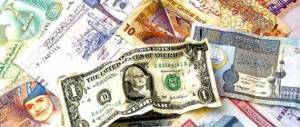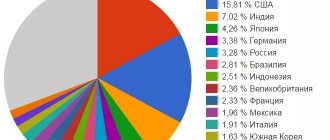Russia's external debt or so-called gross debt is the amount of money borrowed from third-party representatives. Its value indicates how good or bad the situation in the country is. Therefore, any government always strives to reduce external debt. What is the situation in Russia over the years and what does the national debt look like in the country? We’ll talk in more detail in this article.
Why does the US have such a large foreign debt?
America owes a lot to different structures. By the end of 2021, the amount will likely exceed $30 trillion. The national debt has been growing steadily since the 1930s, but no one really cares (except for propaganda).
Let's compare the amount of debt of the United States and other countries in absolute terms (see table 1).
| A country | Amount of debt, billion $ |
| USA | 28040 |
| China | 7996 |
| Russia | 307 |
| Japan | 14655 |
| Germany | 3207 |
| Great Britain | 3592 |
| France | 3179 |
| Italy | 3185 |
Table 1. Government debt by country, 2021
Statistics show that the United States and Japan lead the world in terms of debt. Russia, for example, owes practically nothing when compared with leading debtors.
The huge size of America's loans can be explained quite simply: they allocate funds for development, because... There are not enough internal resources for this. This is not so bad if it pays off and allows the economy to move forward.
Comparison of the value of the largest public companies in Russia and the USA
Here are some of the largest US companies by capitalization:
- . More than $760 billion
- The world's largest in terms of turnover among those selling goods and services via the Internet, Amazon is $680 billion (see Jeff Bezos - biography of the founder of Amazon.com).
- Google Corporation. Total capitalization more than 580 billion.
- Berkshire Hathaway (Warren Buffett's enterprise): $512 billion.
- Facebook: $500 billion
- Microsoft: $510 billion
For comparison, the total capitalization of Russian companies Rosneft, Gazprom, Sberbank, Lukoil is just over $300 billion, which is half the total capitalization of Apple. Thus, having the largest economy in the world, the US can afford to have such external public debt.
US GDP and foreign debt
The absolute values of the country's debt are not so clear and say little. It is much more interesting to compare the ratio of liabilities to income (see table 2) [4]. It is important to note that the amount of external debt is about 33% of the total loans.
| Year | GDP value, billion $ | Amount of external debt, billion $ | Debt to GDP ratio, % |
| 1980 | 2460 | 287 | 11,7 |
| 2008 | 13754 | 3262 | 23,7 |
| 2012 | 15068 | 4948 | 32,8 |
| 2016 | 18524 | 6400 | 34,5 |
| 2021 | 21605 | 9253 | 42,8 |
| 2025 (forecast) | 26013 | 16358 | 62,9 |
Table 2 - Ratio of GDP and US external debt
As you can see, the size of external debt is growing, and by 2025 it will amount to almost 63% of GDP. If we compare the total US national debt and government revenues, it will exceed GDP by 1.9 times by this date. This value is not yet critical, but it is alarming, isn’t it?
The only question is whether America will be able to continue to meet its obligations. Over the past 50 years there have been no problems with this.
Debt structure
Russia's internal and external public debt is represented by the following structure. Internal is divided into:
- State guarantee obligations on securities.
- Loans for banks and other types of lenders.
- Non-payment of compensation to individuals. and legal persons.
All these obligations can be either market or non-market. External is divided into:
- For sold and printed securities.
- Loans from third-party (non-state) lenders.
- Guarantee obligations for external loans.
- Debts on operational obligations at the foreign trade level.
US government debt chart
Let's take a closer look at the graph of America's national debt for almost 100 years [6].
US national debt size, 1930-2020, $ billion
It doesn't take an analyst to conclude that Treasury volumes have increased dramatically since the 1970s. If current rates are maintained, it is possible that the size of liabilities will exceed solvency.
On the other hand, nothing threatens the American economy for the next 20-30 years. If unfavorable circumstances occur, the government will take action (they know how to do this: there is always a hot spot on the planet where you can make money). The same W. Buffett recently made it clear that debts for his country are not a problem, but a benefit [3].
However, it should be understood that such a size of loans is sooner or later fraught with consequences: a global world crisis (if the USA collapses, so will we, as long as the dollar is an international means of payment), a military conflict.
How the USSR debt was paid
The plan of the Russian Federation was this: the country would assume all the debts of the USSR for the refusal of the former union republics from foreign assets. It was assumed that the volume of assets would exceed the debts of the USSR. But the calculation turned out to be wrong.
Some developing countries owed the Russian Federation about $150 billion at the time of Russia's accession to the Paris Club in 1997. But according to the Club’s charter, the new participating country was obliged to write off debts to debtors for the supply of weapons. Namely, this item accounted for up to 80% of the total assets.
In addition, Russia was obliged to write off debts to all poor and developing countries. According to the final calculations, it turned out that other countries owe Russia only $8 billion. Which in the overall debt structure covered no more than 5% of the total debt of the USSR.
After such changes, the Russian economy was unable to pay the debt according to the specified schedule. The Paris and London Clubs provided deferrals for the payment of regular amounts, and in 1992 the Russian Federation offered an aid package from Europe worth $24 billion. However, of this amount, Russia received only 13.6 billion. But in addition, the aid package also included deferments for the payment of debts in the amount of about $7 billion. Therefore, almost 1/4 of the amount was not actually received, but was spent on servicing current obligations.
Russia managed to agree with the Paris Club to provide restructuring for 10 years with a five-year grace period. As a result of the agreement, Russia had to pay 45% of the total debt by 2021, and the remaining 55% by 2115. This is provided that payments begin immediately after the end of the grace period.
The London Club has also restructured its debt payments. The grace period for debt was 6 years. Russia repaid the USSR's debts to some countries not only in money, but also in construction, high-tech goods and other assets.
In 2021, Russia returned the last debt of the Soviet Union. The Ministry of Finance transferred $125 million to Bosnia and Herzegovina for goods that Yugoslavia had given to the Soviet Union. This payment was made on August 8, 2021. It took the Russian Federation 26 years to cover the “inherited” debt.
US government debt counter online (real time)
Initially, an electronic board with the amount of US obligations (per 1 American family) was posted in Manhattan in the late 1980s by entrepreneur S. Durst.
The concerned citizen sought to draw the attention of his compatriots to the exorbitantly growing level of debts of his native country. When every American resident clearly sees how much he “owes,” the Government will have to report and comment.
The first national debt counter near Times Square, New York (photo from 2002)
The idea became popular, and in the age of the Internet it also moved to websites. Now everyone can look at the real volume of American debts: https://usdebtclock.org/ .
The service allows you not only to monitor the increasing figures of public debt, but also includes a number of additional indicators for analysis.
Real-time US debt clock (https://usdebtclock.org/)
Basic statistical information provided by the resource:
- The amount of national debt of the United States and other countries of the world;
- Country's GDP level;
- Structure of public debt;
- America's and Households' Total Assets;
- Main economic indicators, etc.
It will be useful for concerned Americans (and others) to learn detailed information about the economic situation of the state. I would like to see such a resource in Russia, so that we can understand where we are moving not only from TV screens.
What is the alternative to the current financial system?
The current global financial system is based on the use of the dollar as the main, and in fact, the only world reserve currency.
The foundations of the system were laid in 1944 with the formation of the Bretton Woods system and the creation of the International Monetary Fund (IMF).
With the refusal in 1971 from the convertibility of the dollar into gold, the system acquired its modern contours.
The United States, relying on its monetary and economic potential and gold reserves, equated the dollar to gold, securing its status as the main reserve currency. When the system was created, it was declared that it should ensure the balanced development of the world economy through the use of managed floating exchange rates.
As a result, in fact, it led to huge imbalances in world trade, growth in the money supply and increased financial risks.
The redistribution of positions between countries in our time is a reflection of an important feature of modern economic development and competition in the world market.
The exponential growth of imbalances in the global economy began in the 90s, when the created system increasingly began to provide mainly only the growing needs of the US economy. The United States used the dollar's status as a reserve currency to cover its balance of payments deficit with the national currency.
The annual US foreign trade deficit from several tens of billions of dollars in the 80s eventually grew to 500-700 billion dollars. This is the additional volume of goods and services that the United States receives annually in exchange for dollars.
Thus, the United States used the results of other people's labor through the import of goods at the expense of exporting its own dollars.
The founders of the Bretton Woods monetary system believed that foreign exchange interventions aimed at maintaining a parity exchange rate would provide the developed currency agreements with the ability to self-adapt to changes in economic conditions, as the gold standard provided.
However, the unequal monetary mechanism contributed to the strengthening of the US position in the world to the detriment of other countries and international cooperation. The Bretton Woods system was unable to ensure relatively long-term stability of exchange rates.
Against this background, we are seeing strong currency volatility. Exchange rate undervaluation is a relatively painless and simple policy technique designed to increase the competitiveness of one's goods and services in international markets.
Other ways to improve the economy, such as structural reforms, are much more difficult to implement.
The United States, taking advantage of the reserve status of its national currency, has long been printing as many dollars as it needs to finance growing budget expenditures.
An important feature of the modern financial system is that its instruments are no longer supported by a material base, but have become only electronic entries in accounts. This is inherent in the US dollar, securities, derivatives, domestic and foreign debts.
It is obvious that such a financial system, based on the dollar, with the absolute dominance of the United States in the world, is unstable and fraught with collapse. It's only a matter of time, but some alternative is needed.
Payments in national currencies
The beginning of the launch of such an alternative could be settlements between countries in national currencies. Currently, interstate settlements in national currencies are carried out by Russia, China, Belarus, Ukraine, Iran, the UAE and a number of other countries.
General and inter-civilizational financial infrastructures
To ensure settlements in national currencies, an appropriate settlement infrastructure is first required. And such infrastructure is actively being created. In addition to China, Russia uses national currencies in trade with a number of CIS countries.
Gold
It is also necessary to increase the share of gold in foreign exchange reserves, not dollars. Gold is the only monetary asset in the world that does not have the risks inherent in currencies, and is the only globally recognized asset that is not tied to any specific state, and, therefore, in critical cases, including those related to sanctions, can be used in settlements with other countries.
Gold continues to remain an important component of the material and financial basis of the economies of many countries around the world.
It must be taken into account that gold is a competitor to the dollar. And the bulk of gold reserves in gold falls on developed countries. The US is using it to strengthen its reserve currency, the dollar. As you know, Russia is also increasing the share of gold in gold and foreign exchange reserves, which is also not accidental.
The energy standard is a bold step forward
An absolute alternative could be an energy standard for the security of banknotes. Read more about this in the article - “]]>Towards an energy standard through gold]]>”.
There is a concept in economics - the price list invariant, which can serve as the basis of a new financial system. Today, the role of such an invariant is played by the US dollar.
At the same time, the modern credit and financial system is not secured by anything. An invariant price list based on an energy standard can ensure the stability of the global financial system for a long period of time. At the same time, all national currencies in mutual settlements will have a stable exchange rate, which means they will no longer depend on reserve currencies.
If some state announces that it is introducing an energy standard for the security of its national currency and from now on sells all products and raw materials only for it, but not because it wants to, but in order to protect markets and its national currency, then this state will automatically become a competitive economy.
And crises will become a completely understandable phenomenon in world practice. Other states that will be interested in running their own economy will simply follow the example of such a state.
A price list invariant is a product that participates in product exchange along with other products, the quantity of which calculates the prices of all other products without exception. The price of the invariant itself is always constant and equal to 1, which gives the name to the term.
In the past, the price list invariant also served as an intermediary product in the two-step “T1→D→T2” scheme, that is, the invariant function and the function of being a means of payment were merged together.
Now there is no need for this, since after the spread of “credit money” and various “money surrogates” that do not have any intrinsic value, the functions of the invariant and the means of payment were separated and ceased to be connected.
The means of payment have become pseudo-invariant, so money in our time is what society perceives as money.
Therefore, today the price list invariant can only fulfill its direct role - or the first function of money - to be a measure of the prices of all other products.
State banks instead of private offices
Today we need a different credit and financial policy. But it can be different in a sovereign state with a national bank, the goal of which will be the restoration and development of production as a single system, and not the profit of bankers.
What will an increase in public debt lead to?
Debt obligations, within reasonable limits, can give impetus to economic development. If the size of the national debt begins to exceed solvency, then a crisis in the US economy - and, accordingly, the entire planet - cannot be avoided. This is due to the fact that the dollar is an international means of payment. Moreover, there are significantly more of these same dollars abroad than within the country.
Let's give a simple example. You take out a loan from a bank at an indecent interest rate (from 18 to 30% per annum). It rarely happens that the loan amount is less than your salary for the year. Most of Russia, by the way, lives like this and does not complain. It is known that some citizens give almost 50% of their income to banks for loans.
In America, the situation is similar, but on significantly more favorable terms. They pay about 1% of the debt amount annually (not 20% like we do). Isn't this beneficial? When compared with the size of GDP, this amounts to 1.3-1.6% today. Even if the US national debt increases 10 times, then 15% of payments is not so scary.
Many Russians give 70% of their income to banks. Moreover, we take funds for needs, “wants”, and the American Government – for economic development. They borrow to make a profit, and not just to spend on a new car, apartment, or TV.
It turns out that the increase in America's national debt is not critical for them - up to 1000% of the country's GDP. It will take at least 100 years to reach this magnitude. However, for obvious reasons this will not be allowed, because the consequences will be unpredictable.
Myths about foreign debt
“America is in debt like silk” - that’s what the domestic media is encouraging us with. Everything is fine in Russia, but the decaying West will soon go bankrupt. Ordinary people swallow this with pleasure, forgetting that they themselves are up to their necks in loans with extortionate interest rates. This is beneficial for the state. Therefore, there are many myths about America’s foreign debt [2]. Let's dispel some of them.
The US owes foreigners more than it earns
Despite the fact that the national debt of the United States exceeded 30% of GDP by the beginning of 2021, its external part is only 33% (which is significantly lower than the size of GDP). It should be understood that they do not pay this amount immediately, but split it into tiny amounts over many years.
China will bring down the US economy
It is not profitable for China to destroy a market in which they have huge profits. Statements to the contrary are only needed for political intrigue. Even if the Celestial Empire decides to take such a step, it will only lose.
How China supports the US economy. China is the largest foreign holder of US Treasuries. China is also buying US debt to support the dollar. China's role as America's largest banker certainly gives it some leverage. However, it remains an export economy, and the American consumer is its largest buyer. Image credit: Michela Buttignol.
An attempt to sell even a trillion dollars will lead to a reduction in price, and this is unprofitable, since you will have to sell the money at a lower price. The principle of “melting dollars to do mischief” does not work in serious economic activity.
Americans can no longer pay their debts
There is a widespread myth that the US is no longer able to pay its obligations. In fact, the amount of contributions is equal to 1-1.5% of the country’s annual income.
Such statements are made solely for the purpose of propaganda, shifting emphasis and managing the agenda.
Taking into account economic growth and investment injections, this amount does not pose any threat to the economy. Loans from third-party and domestic investors allow you to raise the level of your own producer on the world stage, preventing other players from capturing interesting and highly profitable markets (the phenomenon of concentration and monopolization of capital).
America is about to collapse
Nothing predicts such an outcome. As a result of unforeseen circumstances, anything can fall, but due to the huge national debt, the United States will definitely not go bankrupt in the next 100 years. And it is too early to rejoice at the fall of America, since even the Russian economy is heavily dependent on the dollar. The end will come for us too.
First we need to get rid of dollar dependence, and only then talk about the benefits of the crisis in the United States.
In the meantime, proletarians of all countries, unite!
Terminology and individual concepts that should not be combined into one - public debt
A country's public debt (public dept) refers to the financial borrowings of the country's government to pay off the budget deficit.
Public debt is calculated in a country's national currency or in US dollars, but for greater clarity it is displayed as a percentage of borrowing from that country's GDP (i.e. % of the size of the economy - Table 1). Government debt should not be confused with external debt.
Public debt today mainly exists in the form of bonds in the domestic and foreign markets, and private debt in the form of bank loans (commercial, mortgage, consumer, etc.).
External debt is defined as the sum of public and private debt repayable to non-residents in foreign currency, goods or services (Table 1).
And it is he who shows the total debt burden on the country’s economy.
The presence of significant external debt in foreign currency is regarded as a serious threat to the stability of the national currency and the entire national economy. This clearly indicates that part of the national wealth belongs to foreigners.
Gold and foreign exchange reserves (international reserves or official reserves) are external highly liquid assets, presented in the form of foreign currency and gold, which are under the control of government authorities of monetary and credit regulation and at any time can be used to finance the balance of payments deficit, for interventions in foreign exchange markets influencing the exchange rate of the national currency, or for similar purposes (Table 1).
Country distribution statistics - external debt, public debt, inflation and assets (reserves)
Table 1 (in empty cells - no data)
Country External debt size (in US dollars) Reserves (in US dollars) Inflation in %
(]]>CIA Factbook 2021]]>)
Our table represents more than two hundred countries, so for convenience, let's divide them into two groups - developed and developing.
This must be done in order to highlight their total share according to the indicators given in Table 1 for 2021 and compare them. But first, let's list these countries by group.
Advanced economies (41):
Europe and Middle East - Austria, Belgium, UK, Germany, Greece, Denmark, Israel, Ireland, Iceland, Spain, Italy, Cyprus, Latvia, Luxembourg, Malta, Netherlands, Norway, Portugal, San Marino, Slovakia, Slovenia, Finland , France, Czech Republic, Switzerland, Sweden, Estonia, Liechtenstein, Monaco, Vatican City and Faroe Islands;
Australia, Oceania and the Far East - Australia, Hong Kong, New Zealand, Singapore, Taiwan, South Korea and Japan;
North America - Canada, USA and Bermuda;
Emerging economies (153):
Europe - Albania, Bosnia and Herzegovina, Bulgaria, Croatia, Hungary, Kosovo, Lithuania, Macedonia, Montenegro, Poland, Romania, Serbia, Turkey;
CIS - Armenia, Azerbaijan, Belarus, Georgia, Kazakhstan, Kyrgyzstan, Moldova, Russia, Tajikistan, Turkmenistan, Ukraine, Uzbekistan;
Asia - Bangladesh, Bhutan, Brunei, Cambodia, China, Fiji, India, Indonesia, Kiribati, Laos, Malaysia, Maldives, Marshall Islands, Micronesia, Mongolia, Myanmar, Nepal, Palau, Papua New Guinea, Philippines, Samoa, Solomon Islands , Sri Lanka, Thailand, East Timor, Tonga, Tuvalu, Vanuatu, Vietnam;
Latin America and the Caribbean - Antigua and Barbuda, Argentina, Bahamas, Barbados, Belize, Bolivia, Brazil, Chile, Colombia, Costa Rica, Dominica, Dominican Republic, Ecuador, El Salvador, Grenada, Guatemala, Guyana, Haiti, Honduras, Jamaica, Mexico, Nicaragua, Panama, Paraguay, Peru, Saint Kitts and Nevis, Saint Lucia, Saint Vincent and the Grenadines, Suriname, Trinidad and Tobago, Uruguay, Venezuela;
Middle East, North Africa - Afghanistan, Algeria, Bahrain, Djibouti, Egypt, Iran, Iraq, Jordan, Kuwait, Lebanon, Libya, Mauritania, Morocco, Oman, Pakistan, Qatar, Saudi Arabia, Sudan, Syria, Tunisia, UAE, Yemen ;
Tropical Africa - Angola, Benin, Botswana, Burkina Faso, Burundi, Cameroon, Cape Verde, Central African Republic, Chad, Comoros, Democratic Republic of the Congo, Republic of the Congo, Cote d'Ivoire, Equatorial Guinea, Eritrea, Ethiopia , Gabon, Gambia, Ghana, Guinea, Guinea-Bissau, Kenya, Lesotho, Liberia, Madagascar, Malawi, Mali, Mauritius, Mozambique, Namibia, Niger, Nigeria, Rwanda, Sao Tome and Principe, Senegal, Seychelles, Sierra Leone, South Africa, South Sudan, Swaziland, Tanzania, Togo, Uganda, Zambia, Zimbabwe.
This classification is presented by the IMF and includes 188 countries plus six countries that are not members of this organization - Andora, Bermuda, Faroe Islands, Liechtenstein, Vatican City and Monaco. These countries belong to developed economies and are represented by the World Bank (WB). (]]>https://ru.wikipedia.org/wiki/Developed_countries]]>)
Evaluation of indicators from Table 1
In 2021, the external debt of all countries was $106,554,860,470,418. Advanced economies accounted for $68,221,197,600,000 or 64% of the total debt.
In terms of external debt, the leaders in this group are the European Union - $29.2 trillion, the USA - $17.9 trillion and the UK - $8.1 trillion, respectively. The external debt of countries with developing economies amounted to $38,333,662,870,418 or 35.9% of total debt.
Considering that there are only 41 countries with developed economies and 153 with developing economies, then the total external debt of $68.2 trillion is very large.
External debts clearly show which countries are producers of goods and which are only consumers.
In 2021, the gold and foreign exchange reserves (hereinafter - gold reserves) of all countries amounted to 12,010,975,361,803 dollars.
If this indicator is compared with the external debts of all countries, then it is much less - only 11.2% and cannot fully cover the entire amount of debts. Countries with developed economies accounted for $4,719,843,416,946 in gold and foreign reserves. The remaining group of countries already has 7,291,131,944,857 dollars in gold and foreign currency reserves.
According to the size of public debt, countries were formed in which it significantly exceeded 100% of GDP. The group of advanced economies in 2021 was led by Japan, Greece and Italy.
Japan's public debt was 236.4% of GDP, Greece's was 181.9%, and Italy's was 131.5%, respectively. In the group of countries with developing economies, the leaders in this indicator were countries such as Lebanon - 152.8% of GDP, Yemen - 135.5% and Barbados - 132.9%, respectively.
In most advanced economies, public debt was either approaching 100% or had already exceeded this mark. For public debt, the value of 60%, announced in the Maastricht Agreements, is considered critical, but even countries with developing economies have surpassed this mark.
Inflation rates in the group of countries with developed economies are quite low. Iceland has the highest rate in this group - 4.1%. The second group of countries has significantly higher inflation rates.
Venezuela was in the lead with 2200.02%, Yemen with 21.04% and Argentina with 20%. This factor indicates that there is too much money in circulation in the state, as a result of which it depreciates. And this, in turn, inevitably leads to higher prices.
These statistics of distribution by country for 2021 changed for almost all indicators. Unfortunately, every year in a larger direction, which negatively affected the global financial system - the world economy.
And since many countries, not only developed but also developing, are tied to the world market, where all payments are made in dollars and euros, these countries are not immune to the risks associated with the global economic crisis.
And, if the total global debt increases at a rapid pace, then the global crisis develops permanently.
There is also such a thing as the structure of global debt, which includes the debts of governments, corporations, banks and households of all countries combined. The total debt of all countries must be compared with global GDP.
Based on this indicator, you can understand how much unsecured money there is in the world.
economy and in what currency. Let's look at the diagram below.
In the diagram we see the dynamics of quantitative indicators over the year. The biggest borrowings of 2021 are from corporations and governments. The dynamics of debt growth show the same thing.
Under this scheme, global debt in 2021 was $222.6 trillion . This amount exceeds global GDP - $70 trillion by 3.18 times.
This means that $152.6 trillion in the global economy is unsecured money. The fact that an unsecured amount of money equal to more than two world GDPs is in circulation means, at a minimum, the following.
First : those who have a printing press cleverly redistribute huge flows of various raw materials and products in their favor.
That is, using the advantage of the reserve currency, they actually withdraw part of the world GDP that was created by other market participants. Here we must take into account that the level of US consumption, according to various estimates, is about 40% of world GDP.
And if we take into account that almost the entire manufacturing industry was exported to China, Vietnam and other countries, then the share of their production in world GDP is incomparably less than 40%.
And second : the overwhelming majority of world capital is of a speculative nature and is not invested in real production, but mainly in exchange-traded instruments.
If we take the external debts of developed countries only - $68.2 trillion, then they are almost equal to world GDP.
That is, this group of countries has not yet produced anything, but has already received net investment in their own economy in an amount equivalent to world GDP. As for countries in emerging markets, which also have debts, they want to ensure the same level of consumption as in economically developed countries.
But, given the dominant culture, this trend is destructive for nature and civilization as a whole.
US National Debt - FAQ
How much is the US foreign debt for 2021?
At the beginning of March 2021, the US national debt is 28.04 trillion. dollars. The year before, it was about 25 trillion. $.
How much is the US foreign debt for 2021?
The US government debt was formed as a result of the issue of government bonds. Americans borrow money from various countries to develop their economy, paying back a small portion of what they borrow each year.
Who does the US owe?
The structure of America's public debt is represented by two leaders in the foreign market: China (about 19%) and Japan (about 19%). The share of all foreign agents is about 33% (the rest is domestic loans).
Why did they create an online US foreign debt counter?
Businessman S. Durst in 1989 in New York installed an electronic board displaying the amount of the country's debt in real time and the average amount for each family. The main goal is to attract the attention of the public (which is concerned about this circumstance) to the increasing pace of loans from foreign and domestic counterparties.
What will happen if all the countries in the world hand over their dollars to the Americans?
The world economy will collapse, which will benefit almost no one. The price of the dollar will fall greatly due to excess supply, this will freeze trading and banking operations, which, in turn, will freeze not only the United States, but almost everyone (since many transactions between countries are carried out in dollars).
Why is America often reproached for its foreign debt on Russian talk shows?
In order to distract from internal problems, it is beneficial for propaganda to talk about imaginary problems in other countries. The US has always been portrayed in a negative light on domestic TV (often for good reason), but foreign debt is not at all an issue today.
What size of US national debt is critical?
According to economists and analysts, America will easily carry a debt of 200-300% of the country's GDP. Today it is about 130% of GDP, and by 2025, according to forecasts, it will reach 190%. So the reserve is still large enough for the Government not to worry. A size of 1000% can be considered critical.
Russia's debt status today
The table shows the structure of Russia's external public debt as of January 1, 2021, according to official data from the Ministry of Finance of the Russian Federation:
| Debt category | million US dollars |
| State external debt of the Russian Federation (including obligations of the former USSR accepted by the Russian Federation) | 56 478,0 |
| Debt to bilateral creditors not members of the Paris Club | 349,5 |
| Debt to multilateral creditors | 473,8 |
| Debts on external bond loans | 38 257,7 |
| external bond loan with maturity by year in: | |
| 2022 | 2 000,0 |
| 2023 | 3 000,0 |
| 2025 | 2 148,1 |
| 2026 | 3 000,0 |
| 2027 | 920,6 |
| 2027 | 2 404,6 |
| 2028 | 2 499,9 |
| 2029 | 3 000,0 |
| 2030 | 2 250,1 |
| 2035 | 4 000,0 |
| 2042 | 3 000,0 |
| 2043 | 1 500,0 |
| 2047 | 7 000,0 |
| Debt under OVGVZ | 2,7 |
| Other debt | 22,6 |
| State guarantees of the Russian Federation in foreign currency | 17 679,7 |
In accordance with Art. 6 of the Budget Code of the Russian Federation, obligations in foreign currency are included in Russia’s external public debt.
You can see what external debt Russia has in real time using this link. There you can see data only on total debt, but also in terms of per capita, for the year and at the current moment.
about the author
Klavdiya Treskova - higher education with qualification “Economist”, with specializations “Economics and Management” and “Computer Technologies” at PSU. She worked in a bank in positions from operator to acting. Head of the Department for servicing private and corporate clients. Every year she successfully passed certifications, education and training in banking services. Total work experience in the bank is more than 15 years. [email protected]
Is this article useful? Not really
Help us find out how much this article helped you. If something is missing or the information is not accurate, please report it below in the comments or write to us by email
List of sources
- US national debt in real time. URL: https://fincan.ru/articles/13_gosdolg-ssha-v-realynom-vremeni/
- Myths about the US national debt. Oleg Komolov // Prime numbers. URL: https://www.youtube.com/watch?v=ZgwBDtrFYpE
- Why the US will never default on its debts. URL: https://fomag.ru/news/pochemu-ssha-nikogda-ne-obyavyat-defolt-po-svoim-dolgam-mnenie-uorrena-baffeta/
- US national debt counter. URL: https://usdebtclock.org/
- The US has a debt to China of $1 trillion. URL: https://prc.today/u-ssha-dolg-pered-kitaem-v-razmere-1-trln/
- US National Debt by Year Compared to GDP and Major Events. URL: https://www.thebalance.com/national-debt-by-year-compared-to-gdp-and-major-events-3306287
The title photo shows “trends of social collapse in the USA.” Author: Huffington Post.
Finally, we recommend watching the video “Myths about the US national debt” from Oleg Komolov:
Subscribe to our channel on Telegram
to receive the latest articles in a timely manner!











